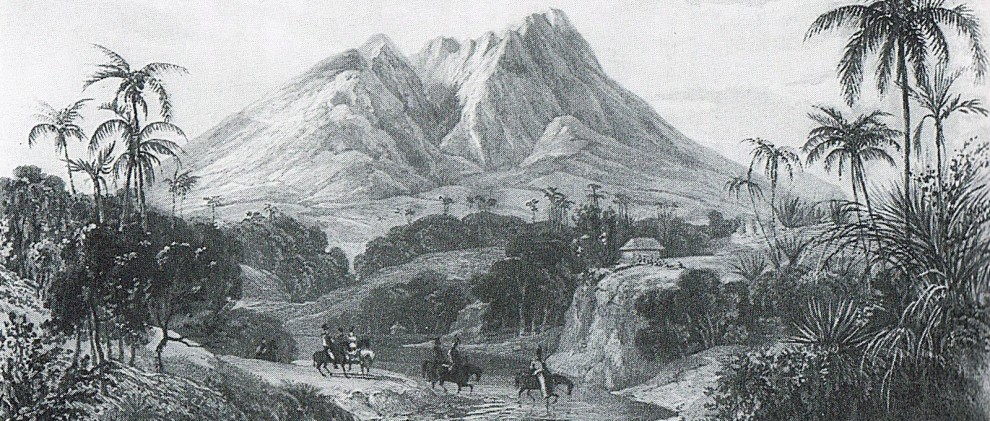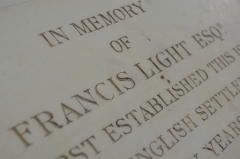Once the British had successfully conquered Java in 1811 they were left with an enormous island to run, and a serious problem with manpower. The invasion itself might have been a grand project, but after the troop ships departed in October 1811 the new British colony was left with a skeleton crew. Just as in the bad old days of the VOC, men with questionable qualifications were pressed into purposeful roles. The Dutch had run Java through a series of residents in different districts, under who were subdivisions of local regents. Despite the strident anti-Dutch propaganda that had accompanied the invasion – with its talk of misrule and corruption – so severe was the shortage of staff that leaving many of these original administrators in place was Raffles’ only option. Over the early months of British rule detailed reports were called in from these far-flung Dutchmen, sweating in their crumbling bungalows all over Java.
Grovelers and groaners
The residential reports give an amusing glimpse of the gamut of attitudes and emotions amongst the Dutch at the British takeover. Some were upright but apologetic. The newly appointed resident of Karawang, a man by the name of W. Offers, bemoaned the state of the territory he had recently inherited – the roads were so bad “that it was impossible to go even on horseback from one Regency to another in the Rainy Season”. He was eager to stress, however, that none of this was his fault, and he gave assurances of the district’s potential.
Other residents – like the head of the Eastern Districts, van Middelkoop – sent in reports brim full of recommendations. There was no beseeching; only sober recommendations for administrative changes, lists of the superfluities that could be cut and the gaps that should be plugged, and a faint hint of disproval at these ignorant incomers. Other reports, like that of Engelhard the Yogyakarta resident, were awash with worldly weariness.
Still other Dutch residents abandoned all dignity in their fawning desperation to cling to their jobs under the new management. The Cirebon resident, Matthias Waterloo (who had previously been based at Yogyakarta), abased himself before the mighty British in his grovelling report, declaring his “readiness to shake off a yoke which had become unsupportable” and heartily recommending himself and his family to British protection. “No Hollander ever will be a Frenchman”, he declared. However, he was obviously as terrified of being judged a traitor to his own flag by the British for throwing himself so fully on their mercy as he was of the prospect of unemployment: “It is not to serve an enemy to my mother country that has induced me to enter into the service of the British Government, by no means” he simpered; “I can declare with the most sacred truth that I never would have thought of it if I still had been under the Dutch Government”. It was all the fault of those terrible Frenchmen! He went on labouring this point for two whole pages.
Waterloo was also eager to stress the prospects of his district. “Wheat and all sorts of vegetables and fruits of the earth… would grow luxuriously if there were only persons here who had a sufficient knowledge of the mode of growing them,” he breathlessly declared. The problem, of course, was the natives: “The Javan of Cheribon is very lazy and in the highest degree superstitious a slave to his ancient customs and therefore very difficult to reason with. Timid and effeminate, there is no such thing as spirit or enterprise…”
In truth, the economic failure of Java had a great deal more to do with Dutch methods than some fatal flaw in “the native character”. By the turn of the 19th century their empire under the aegis of the VOC had been in a state of terminal decline. Meanwhile, as quasi-commercial colonialism went to seed, the Javanese had been quietly reasserting their glittering pre-eminence in the green heartlands of Central Java. By the time Raffles arrived, Yogyakarta was a truly great town.
Return to glory
The Javanese royals who had presided over the chaos of late-Mataram, and who had seen the partition of the kingdom, had passed away into the realm of spirits, and towards the end of the 18th century a new generation of aristocrats had taken control of the courts. These were the men who would be on the various thrones when the British arrived in Java, and while their fathers – by studiously ignoring each other, and making sure that they were never required to meet in person – had managed to bring a certain legitimacy to the divided kingdom, the younger men would look to test both the clauses of the Giyanti Treaty, and the resolve of the Dutchmen.

- Sun of Kings: Hamengkubuwono II
The second post-partition Susuhunan of Surakarta ascended to the throne in 1788, and almost immediately came close to provoking a major confrontation with both the VOC and the rival Javanese courts. The second Sultan of Yogyakarta, meanwhile, was crowned in 1792. He had already rebelled against his aging father, overseen the erection of a grand curtain wall, 45 feet high and three miles long, ringing the entire Kraton including the Taman Sari and attendant quarters, and had written a mystical text entitled the Book of the Sun of Kings in which Mataram was reunited and the European colonialists in Java were annihilated by the combined forces of God, the Queen of the Southern Ocean, and a righteous – and decidedly autobiographical – prince. If the officials of the Dutch VOC hadn’t been so drunk, decrepit and depressed they would probably have been worried.
Forts and failure
By this time, however, the VOC was on its very last legs. Throughout Mangkubumi’s illustrious reign as Sultan the Dutch had never really managed to get the measure of Yogyakarta (the first Sultan’s “most notable physical trait”, it was recorded, “was the habit of answering importunate Dutch requests with an enigmatic smile”), and even once his somewhat less illustrious son took over they struggled to understand, let alone orchestrate, events inside the Kraton. They had built a fine official residence on the northern edge of the Alun-Alun and had installed a European official as representative at the court, but their attempts to build a small fortress just to the east of the residency had turned into a farce. Through corruption, incompetence and prevarication the project took decades. Ground had been broken in 1764, but 16 years later the then resident reported that the work had “made little progress”. Over the next decade a succession of Residents sent reassuring letters to Batavia, promising that the fort was “nearly ready”, but in 1790, more than 25 years after Mangkubumi had sanctioned the project (and after the Javanese themselves had managed to fortify their entire Kraton in a matter of weeks), it was only “very near completion”. In fact it is by no means clear if it was ever really finished, or if the little Dutch garrison had actually properly moved in by the time the British arrived in Java.
The Dutch had a little more control over the court in Surakarta, but the list of late 18th Century Residents there amounted to a procession of the corrupt, the crooked and the conniving. Incredibly, the position of Dutch Resident at Surakarta was unpaid, yet through pilfering from the treaty-sanctioned collection of birds’ nests for the soup trade, through extorting money from minor princes and even from the Susuhunan himself, and through pocketing transport tolls and business duties, the Residents accrued enormous black fortunes. They also generated a great deal of hostility. At least one of them seems to have been poisoned for his efforts.
This then, was the state of the royal Javanese world, and the role of Europeans within it, at the start of the second decade of the 19th Century; these were the courts and the kings who, in the words of one rather romantic British observer, constituted the “the Pith, the Sinews, and the Strength of Java”, and these were the men that Raffles was determined to dominate…
© Tim Hannigan 2013


















